MAX-2015, NIK MiG 1.44 MFI exposure
29 February 2000 was the first time that an experimental fighter jet of the Russian Aircraft Manufacturing Corporation (RSK) MiG, known as Item 1.44, took off the ground. The test flight took place at the flight test and development base (LI and DB), located at the airfield of the Flight Research Institute. M.Gromov in the suburban town of Zhukovsky. The flight, which lasted 18 minutes (from 11: 25 to 11: 43 Moscow time), was carried out in full accordance with the task. The aircraft gained an altitude of about 1000 m, flew two laps over the airfield at a speed of 500-600 km / h, after which it successfully completed the landing.
Work on the 1.42 program began as early as the end of the 70-s, when priorities in the requirements for the future fighter were outlined. They should have been the following areas:
- multi-functionality, assuming equal opportunities in actions on air and ground targets;
- small visibility in all spectra (visual, radar, thermal and electromagnetic);
- super-maneuverability, which involved the implementation of unconventional methods and tactical elements of air combat, as well as expanding the range of possible flight regimes without reaching the brink of stalling and stalling;
--- supersonic cruising flight speeds, allowing to carry out an energetic air combat manner, imposing initiative on the enemy and a quick response to the changing tactical situation.
Preliminary common features of the fighter, which received the temporary cipher KB of the product 5.12, took shape at the beginning of the 80-s. The name, to preserve secrecy, was given by analogy with what was used in the working documentation on the MiG-29, with further refinement of the modification (9.12, 9.13, 9.15 and others). Thus, even with an accidental information leakage, the impression was created that this was one of the variants of the MiG-29. The general management of the topic was carried out by the General Designer Rostislav Belyakov, the chief designer was Georgy Sedov (later replaced by Yuri Vorotnikov).
When designing it, all the same requirements were based on it, but priorities changed somewhat:
supersonic cruising speed;
maneuverability;
stealth
The implementation of quite contradictory requirements required a large amount of research. The shift in emphasis led to significant differences in the MFIs scheme from the fighters of the previous generation that entered service: they had to abandon the integral layout, which significantly increased the mid-section and contradicted the requirements of cruising supersound, the wing lost its influx and acquired positive transverse V, new control surfaces were proposed, for which had to find a name. At the same time, in the IFIs, according to one of the designers, an evolved MiG-25, a high-speed fighter that had grown to a qualitatively new level, was viewed. The aerodynamic concept of MFIs was worked out at TsAGI, which recommended the following solutions for their implementation:
- Scheme duck, beneficial both in terms of maneuverability, and the best bearing properties, with rear centering, unstable statically;
- a large area and triangular wing with a sweep on the leading edge of the 40-45;
- deviation of the thrust vector of the engines to improve take-off performance and ensure super-maneuverability;
- adjustable adjustable air intake, supersonic and subsonic, as well as at low speeds and high angles of attack and having less radar visibility due to shading from above with the fuselage;
--internal or conformal placement of weapons.
The draft design of the IFI was submitted to the leadership of the Air Force and was successfully defended by the state commission. After passing through the mockup commission that approved the look of the IFI, the refinement and refinement of its scheme continued. The first working drawings for the 5.12 product were already released in the 1986 year, but the original edition (under this term, adopted in the KB practice, is another option in the process of creating a machine) has undergone significant changes. In addition to attracting a mathematical apparatus and a huge amount of blowdowns in TsAGI wind tunnels (not all processes are miscalculated - vortex aerodynamics, which became the basis for mastering large angles of attack, requires full-scale experiments), 5.12 product research on large-scale controlled flying models was launched.
Four-meter half-tone models discharged from a helicopter suspension went into extreme modes, demonstrating the behavior and controllability of a future car at supercritical angles of attack and helping to master techniques for getting out of dangerous conditions.
These tests were not going smoothly. The records made it possible to judge the effectiveness of certain solutions, they were studied by test pilots who received a unique opportunity to evaluate the behavior of the future aircraft, especially in hazardous conditions. In flight models with conventional mechanical control by the 1990 year, it was possible to achieve sustainable behavior without a tendency to stall at corners up to 60 and spin characteristics, enviable, and for machines of stable scheme. In itself, this was promising, as it was previously believed that a statically unstable aircraft of a similar layout, not equipped with a control system with an artificial stability preservation, was practically uncontrollable.
On the basis of continuing research, changes were made to the design. Innovations were introduced at the first prototype assembled at the plant at the design bureau. Work on it began in the year 1989, already under the code project 1.42. By 1994, the project underwent six revisions, four of which were tested on flying models.
Originally it was planned to equip the aircraft with engines with flat nozzles, reducing radar visibility and shielding disks of turbines. However, this design, at first glance, more simple, proved to be difficult to implement because of the poor distribution of temperature fields in the nozzle box during the transition from circular to rectangular, which threatened to burn through the walls. The transition to the flat nozzles had to be postponed, but in the meantime the engines managed to control the thrust vector by deflecting the usual round adjustable nozzles, and from 1991, they were introduced into the main editorial board.
The wing of the MFI with a straight leading edge without the influx differed from that which was generally accepted on previous generation fighters. The formation of vortices flowing down the leading edges and having a positive effect on stability are called upon to carry out PGO mounting beams, the location of which had to be painstakingly selected experimentally - the optimum drift and the descent of the vortices forming the wing flow depend on their installation, thickness and height. This is especially significant with the adaptive design of the wing, when the joint work of the deviating socks and flaperons changes the pattern of flow, adapting the wing to the flight mode.
The task turned out to be difficult: the first two editions with a clean CSO were replaced by the next one, in which the CSG blades (the term stabilizer lost its meaning, since the MFI's front plumage performs mainly other functions) received an impressive whirling tooth. In practice, this solution has already been used in the development of the MiG-23 - then a rotary cantilever was equipped with a tooth, and then a center-plane influx, which had a positive effect on maneuverability.
The corresponding transformation has undergone and placement of weapons. A variant of the internal cargo compartment in the upper part of the fuselage was being worked out, from where rockets would be thrown out by hydropneumatic pushers after the flaps were opened (a design worked out on the MiG-31, albeit with underfusual half-wall placement). Such a placement promised some advantages, facilitating the capture and launching of targets for over-and-over maneuvers. However, it would inevitably cause problems in operation - to lift rockets to four meters high, the mass of which even the lightest Р-73М exceeds 100 kg, and long-range missiles reached 300-400 kg, special cranes and platforms for each aircraft would be required - too expensive, cumbersome and completely unacceptable solution for domestic practice. As a result, the armament compartment occupied a more fitting position in the lower part of the fuselage, where the missiles could be suspended directly from the carts with the help of known simple means.
MFI was supposed to get a new generation radar with a phased antenna array. This design has much greater speed and efficiency than conventional radar with a rotating antenna mirror, less mechanically complex and more resistant to damage. The radar protection of the tail with the detection of the enemy in the rear hemisphere and target designation of missiles, including with a reverse launch, launched backward on the flight (this technique was developed for the P-60 and P-73 missiles) was a novelty in the weapons complex.
In the meantime, there were problems with building a prototype machine. By the end of 1991, the entire Soviet military industrial complex went into a violent crisis. The defense lost its former privileged status, the funds allocated were catastrophically reduced, and many knowledgeable specialists left the enterprises and design bureaus.
With regards to MFIs, this had depressing consequences: the allocated finances were dissolved in the depths of the military-industrial complex, and the construction of the machine stopped at times. In addition, for example, when installing the control system, the Nizhny Novgorod plant Gidromash did not agree to install steering cars without prepayment. Other systems that had to be conserved were also incomplete. Not getting along with the new leadership, test-pilot Mikhail Kvochur left the company, who was to lead the IFI.
In the end, the aircraft, although not yet equipped with part of the units, was transferred to LII at the beginning of 1994. In December, it was the first high-speed taxiing with the separation of the front rack. After that, the era of stagnation came again. The plane was gathering dust in the hangar, and its display, expected from year to year, was constantly postponed under plausible excuses. The vacuum was filled with stupid information from representatives of the company and MAP, confirming the existence of a new fighter (which was unusual even with the arrival of publicity - not a word was said about the presence of Sukhovsky C-37 until its first flight).
The aircraft was shown on 12 on January 1999 of the year at LII, where many journalists, military attaches of foreign countries and a large contingent of domestic dignitaries, including members of the government, were sent by 1.42, were invited. Among those who arrived in Zhukovsky were Russian Defense Minister Igor Sergeyev, Air Force Commander Anatoly Kornukov, Economy Minister Andrei Shapovalyants and presidential aide Yevgeny Shaposhnikov.
As for the aircraft itself, the sample shown was somewhat different from the 1.42 project in its complete design. Therefore, the first flight model of the MFI was built by the 1.44 product with a well-defined and rather narrow purpose — evaluating the aircraft in the air, determining the characteristics of its behavior and controllability, as well as running new engines.
The aircraft is a single-seater monoplane duck scheme with two-tail, according to the domestic classification is close to a heavy fighter. Among the few published characteristics, the wingspan was 15 m, the length was 20 m and the maximum take-off weight was about 30 t. The carbon plastics and polymer composites are widely used in the design, whose share in the total mass is about 30%.
The design of the MFI made of composites made panels of the wing, PGO, covers and sash hatches.
Another novelty - light and durable (but expensive) aluminum-lithium alloys are 35%, steel and titanium - 30%, another 5% falls on other materials (rubber, glass, etc.).
Cruising supersonic should provide two AL-41F turbofans, created by NPO Saturn. Engines equipped with swiveling nozzles have a maximum afterburner thrust of 14000 kgf with a dry weight of 1585-1600 kg. With a normal take-off mass, they provide the aircraft with a thrust-to-weight ratio of the order of 1,3. The assigned resource of AL-41F before the first repair is equal to 1000 hours, the resource of moving parts of nozzles is 250 hours (it is planned to increase it to 500 hours). The engines passed the full range of flight tests at the MiG-25 flying laboratory (306 board). The maximum speed of the MFI should be M = 2,6, and the long-term cruising, achieved without boosting, should be M = 1,4-1,6. The afterburner is considered as a short-term combat when you catch up with the enemy or provide a tactical advantage.
The aircraft is equipped with a ventral air intake, divided into two sections (each servicing its own engine). The air intakes have an upper adjustable horizontal wedge and a lower lip that is deflected, providing smooth control of the flow at the inlet. The design of the input device provided for the 1.42 differs in the arrangement of the lateral bevels and the vertical central wedge, which are more advantageous in terms of stealth. Engine nozzles should also be flat to reduce visibility (by the way, the opinion of a larger IR signature of round nozzles does not correspond to reality - from the rear angles, the detection of IR systems more depends on the degree of bypass ratio of the engines and mixing of the flow that dilutes it with cold air, as well as flame tube profiling and turbine shielding.The 1.42 equipment is also provided with an air refueling system
The lower location of the air intake is also advantageous for the requirements of high maneuvering characteristics, allowing you to avoid disrupting the flow during intensive maneuvers with access to large angles of attack and turns. The aerodynamic scheme of a duck with high load-bearing properties is subordinated to the same (we recall that in an aircraft of a classical scheme, the stabilizer eats up part of the lifting force, while the PGO of a duck gives its positive component). In addition, PGO performs the functions of damping when reaching the critical angles.
The rich wing mechanization — two-section deflectable socks, ailerons and two pairs of flaperons occupying almost the entire front and rear edges — is connected to an electric-powered digital control system that controls the behavior of a statically unstable machine. Its characteristics make it possible to achieve a true symbiosis of the airframe, thrust vectoring engines and on-board equipment, at the same time simplifying the work of the pilot, increasing the sensitivity of control and protecting the machine from going to extreme and extreme modes. In total, the aircraft carries seven pairs of control surfaces, including unconventional ones, such as the rudders on the lower keels and flippers in the root parts of the wing.
The decrease in radar visibility, achieved, in general, by the layout of the aircraft and the radio absorbing coating of its surfaces, can be assessed by 1.44 only by specific design solutions, which reduce the EPR and screen some aggregates that are particularly noticeable in this spectrum. Coverage is not necessary for the initial flight tests, the aircraft does not carry (which was formulated by the developers as the task of the next stage. In addition to the overall layout with smooth contours, including an oval, flattened section of the fuselage, concealment is facilitated by the internal placement of weapons and engine compressors shelter, also giving noticeable irradiation bursts. The air channels leading to them are S-shaped. You can be sure of the effectiveness of this solution by looking into the air inlets: you can only see the curved surface of the channels themselves, going up to bypassing the weapons compartment and completely hiding the input disks of compressors. The gaps in the ailerons, flaps, wing socks and rudders are perfectly minimal.The same unobtrusive technology also submits the installation of the spaced keels on the wing with 15 outwards.
At the same time, a number of solutions, albeit related to the individual features of 1.44, do not fit into modern ideas about ways to reduce EPR: lower keels, which play the role of corner reflectors, disregard of tested sawtooth edges of hatches and panels, angular keel, wing and fuselage joints, Gargroth with the same angles.
Tricycle landing gear with nose wheel. Nose rack with two wheels 620x180 retracts downstream. Due to the tight layout in the area of the air intake, it does not fully fit into the niche and the two doors that close it have a convex trough-shaped shape. The main racks with depreciation of various types are retracted forward. They carry low pressure 1030x320 wheels with ventilated brakes. The use of wheels of the same type as on the Su-25 and Su-27, due to the desire to simplify the design of the experimental machine.
Nose rack
The device of the moving part of the lamp when opening rises on two levers with simultaneous shifting back. Such kinematics can significantly reduce the effort required when opening (with a 10 mm glazing thickness, the lid weighs more than 150 kg) and makes it easier to drive. At the same time, the gaps around the perimeter are quite large, and the glazing itself has a yellowish tint, not because of the gold plating shielding the radiation from the cabin sources, as has been asserted here and there. The secret is much simpler - it is a hereditary disease of heat-resistant glazing of Mikoyan fighters, known for the MiG-25 and MiG-31.
1.44 does not carry armaments, however, bays are reserved and units for its installation are laid. The fighter will carry a built-in 30-mm cannon with an increased effective fire distance, and its embrasure will be closed by a moving flap to reduce radar visibility and for high-speed flight requirements (a similar solution was used on the MiG-31). In the internal compartment, 1.42 will be able to accommodate most types of existing air-to-air and air-to-ground missiles on ejection installations, as well as 5-generation air combat missiles specially designed for MFIs.
Heavy missiles, bombs and outboard tanks can be suspended on three pairs of underwing holders, the nodes of which are also embedded in the wing structure. However, the external load options are not basic, increasing visibility and not allowing supersonic flight.
1.44 does not carry the full range of aim-navigation equipment, limited only by the necessary flight systems (this explains the small cone of the non-standard radar, and some radio transparent fairings on the first machine are simply made up). At the same time, all units of the complex were tested, including at flying laboratories. The aircraft was supposed to install a 5-generation Doppler radar with a phased antenna array, which allows tracking more than 20 targets and simultaneously attacking 6, as well as sighting equipment of optical and IR channels for detecting, tracking and targeting in low visibility. The use of such equipment is considered as a priority under the terms of secrecy (radar gives the aircraft a powerful radiation).
To accommodate the radar rearview and onboard station jamming provided compartments in the keel beams.
Much attention is paid to the automation of problem solving, which is particularly significant in the internal deployment of weapons, when missiles hidden in the GOS compartment need external targeting from aircraft systems to the very moment of launch. In the interaction of the pilot and the machine, I see the principles of the maximum-hit and start-up-forget.
The estimated cost of the MFI came under 70 million.
In parallel with the work on a multifunctional front-line fighter based on the basic design, variants of the reconnaissance aircraft, the ship-based fighter and other modifications were worked out.
In 1999, it was decided to give priority to the developments of the Sukhoi Design Bureau, and to include MAPO MiG in its composition. The motives were probably the high declared price of the MFIs and the statements of M. A. Pogosyan about the superiority of C-37 over the MFIs for TTX and the possibility of launching it into a series in the near future.
Despite this, work on the MFI continued, and 29 February 2000, the first prototype of the MiG 1.42 still rose into the air. The first flight of the 1.44 took place at the airfield of LII im.M.M.Gromova in Zhukovsky. 18 minute flight took place at a speed of 500-600.km / hour. The plane was piloted by test pilot Hero of Russia V.Gorbunov. However, the new head of the design bureau was not interested in the further development of another project, despite the failures of its own C-37 and the high level of readiness of the MFI, which could already be put into mass production at Sokol. As a result, in 2002, the government issued a resolution on the establishment of the PAK FA, which finally buried both the MFI and C-37.
27 on April 2000. 1.44 made a second 22-minute test flight. In flight, a number of aircraft and propulsion systems were tested, and, besides, unlike the first flight on a fighter, the landing gear was released and retracted.
At 2013, the only flight copy is in the LII. MM Gromov in Zhukovsky, abandoned in the open. It was decided on the final conservation of the specimen in the hangar.
In August 2015. MiG Russian Aviation Corporation has announced the resumption of work on a light promising fighter. aviation experts suggest that they will be based on developments on the project 1.44.
The mechanization of the rectilinear trailing edge of each wing console includes two-section elevons.
Front horizontal tail - all-turning. It is located above the plane of the chords of the wing. There is a vortex-forming "canine" on its nose. PGO is used not only as a body of aerodynamic control of the aircraft. When flying at high angles of attack, it is involved with the wing in creating lift.
Larger
The cabin is equipped with a modern display system. The pilot can choose the required amount and type of information on the multifunctional electronic indicators.
The structure of the cabin equipment was planned to include a special on-board device for assessing the physical condition of the pilot KSL. It will not only inform the pilot about the overload levels beyond his organism, but will also automatically take the aircraft to a safe mode if the pilot loses consciousness.
The aircraft’s navigation equipment had to include inertial and satellite navigation systems, a radio navigation system for near navigation and landing, a radio altimeter and other equipment used on the aircraft of this class.
General view from the board of the Tu-155.
The airplane's lantern is two-piece, in configuration it is close to the lantern of the MiG-29 fighter. The lantern smoothly passes into the grotto, ending in the area of the engine nozzles by the steamer. In the central part of the fuselage are the main fuel tanks, S-shaped air ducts of engines and niches for cleaning the main landing gear supports. In the air intake gondola there is a niche for cleaning the front landing gear.
Small parts
Theoretically, the state of the aircraft allows you to take off, but in practice this will require serious organizational preparation and huge resources.
In LII named after Gromov reported that in the year for the maintenance of the aircraft in the hangar can cost about 8 million rubles.
Modifications:
The aircraft with the 1.42 code is the prototype on which the MiG design bureau technology was tested according to the I-90 project. Built 1 prototype (1994), which was used for static tests.
The aircraft with the 1.44 code is a modified 1.42. He had to go into mass production and enter the army. 1 instance was built (1999), 4 was still at the Sokol plant at different degrees of readiness at the time of project closure. (Our board)
The aircraft with the 1.46 code is a deep upgrade of 1.44, significantly superior to it in TTX. At the time of closing the project was preparing for the construction of a prototype.
LTH
Crew: 1 people
Length: 17,3 m
Wingspan: 11,99 m
Height: 4,73 m
Weight:
empty: 18000 kg
maximum take-off weight: 23500 kg
Engine:
Engine: twin-turbojet with afterburner and thrust vector control AL-41F
Thrust: afterburner: 2 × 18000 kgf
Maximum speed: up to 2400 km / h
Top speed at height: 3180 km / h
Maximum speed at the ground: 1500 km / h
Practical range: 4000 km
Service ceiling: 20000 m
EPR: less than 0,3 m²
Cannon: 30 Built mm gun GSH-30-1
Combat load: up to 12000 kg
for air combat, in the weapons bays: 12 × P-77 or P-73
against ground targets, in weapons bays: 2 × X-55, X-61, X-41, or 8 × X-29, X-31, or 12 × CAB-500, ODAB-500
Suspension points:
Internal: 12
External: 8
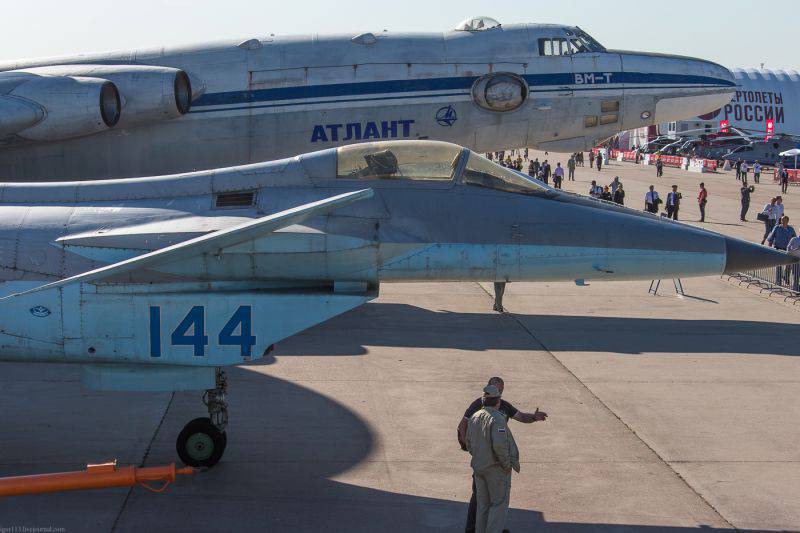
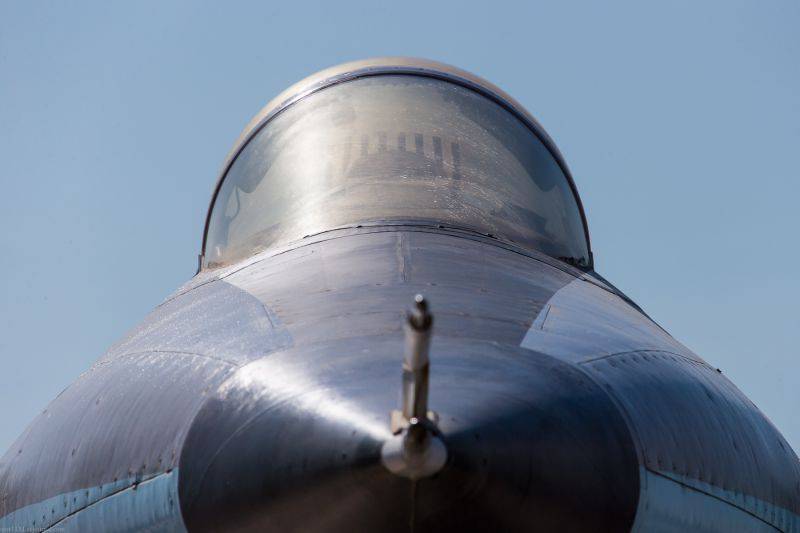
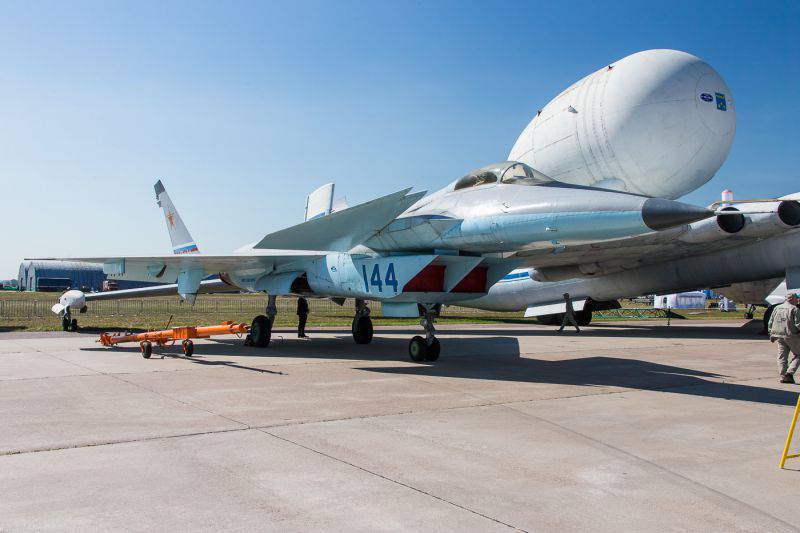
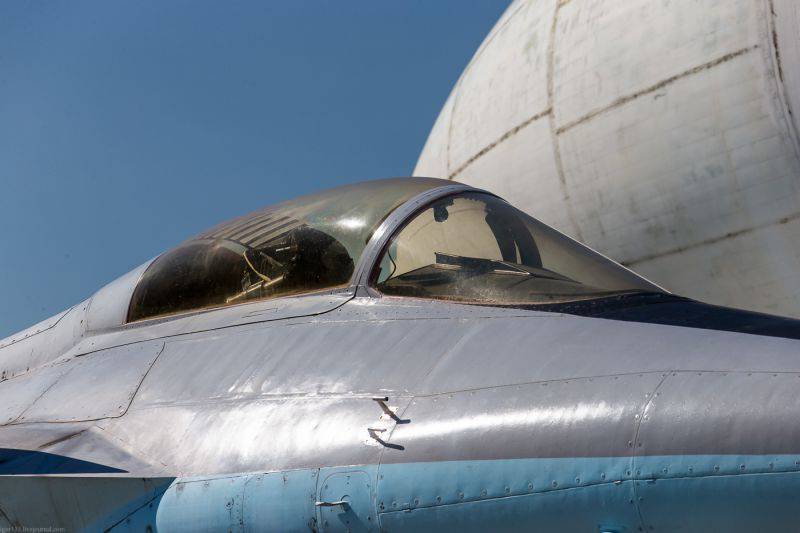
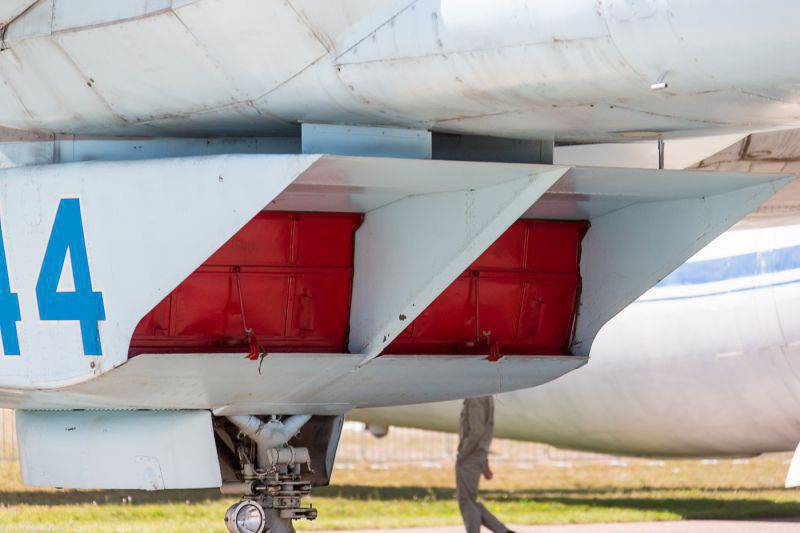
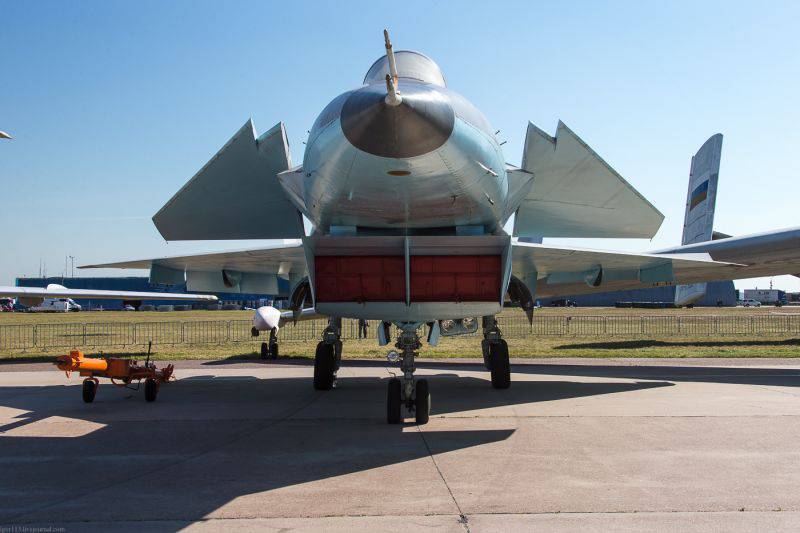
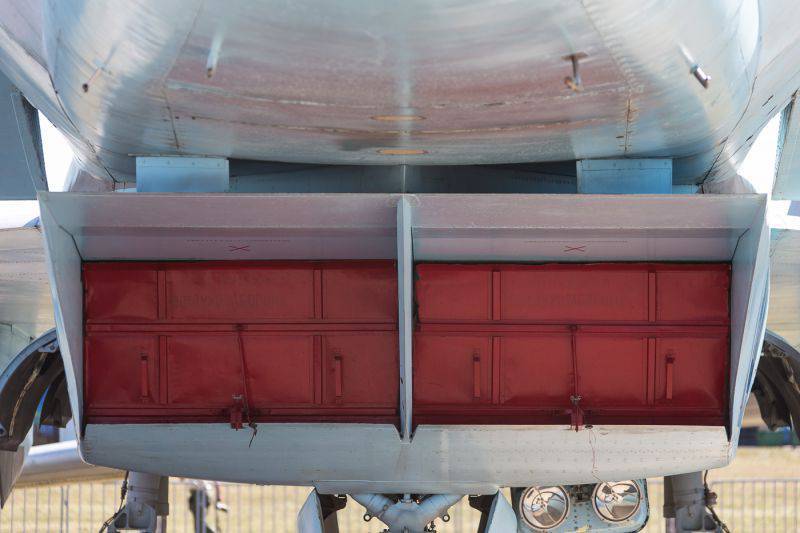
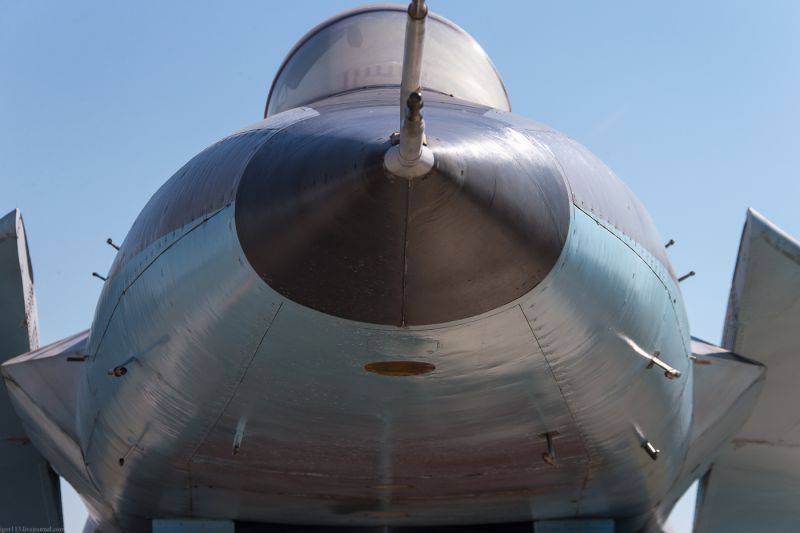
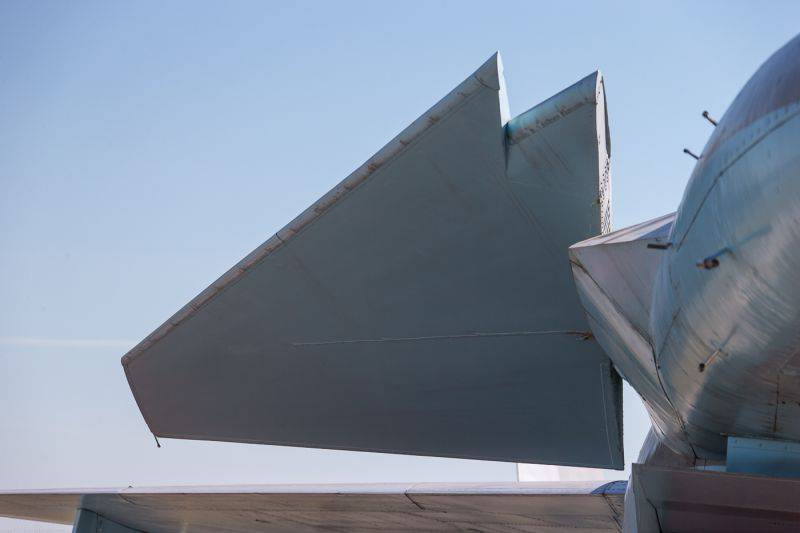
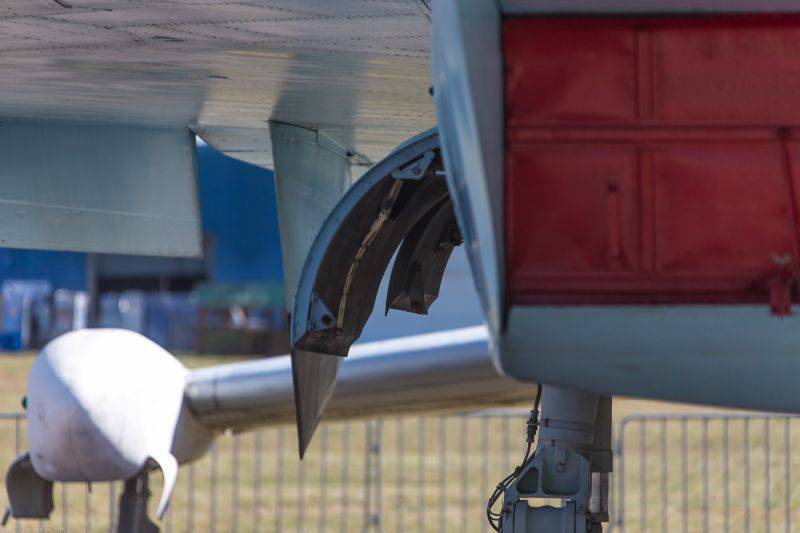
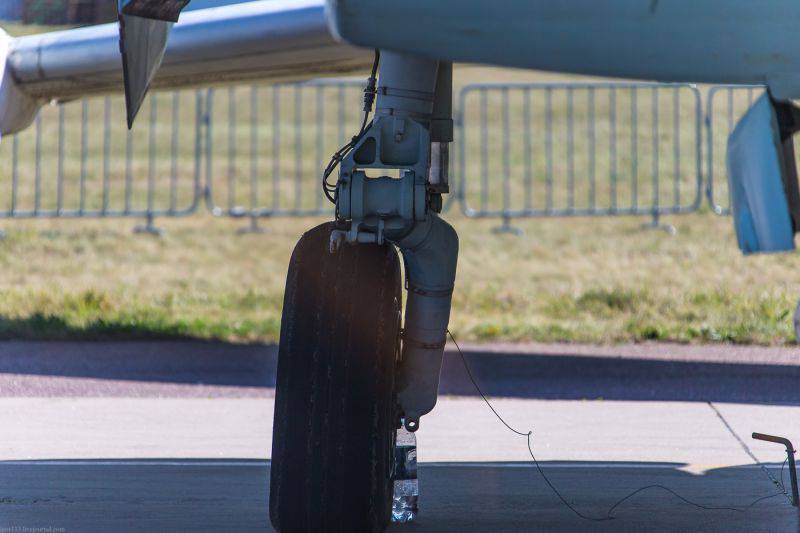
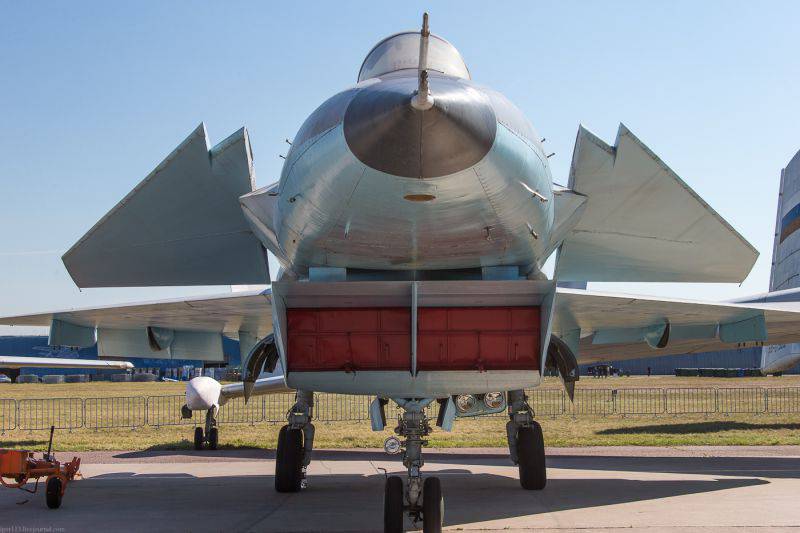
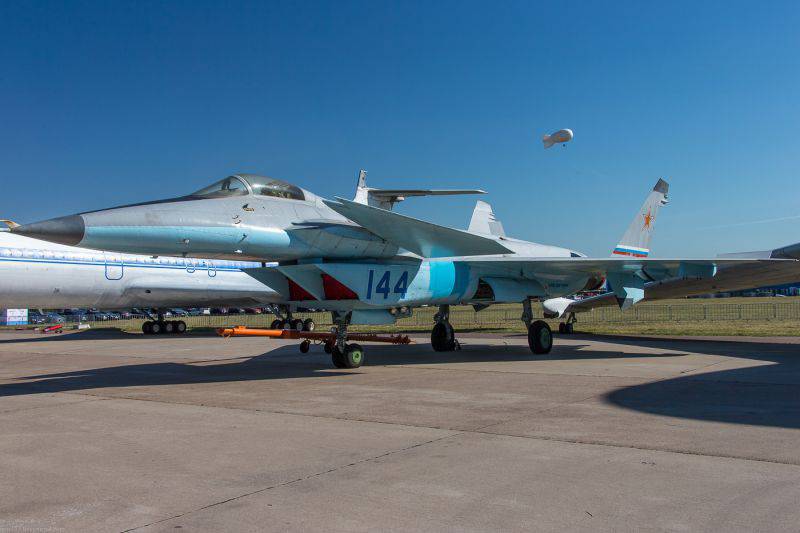
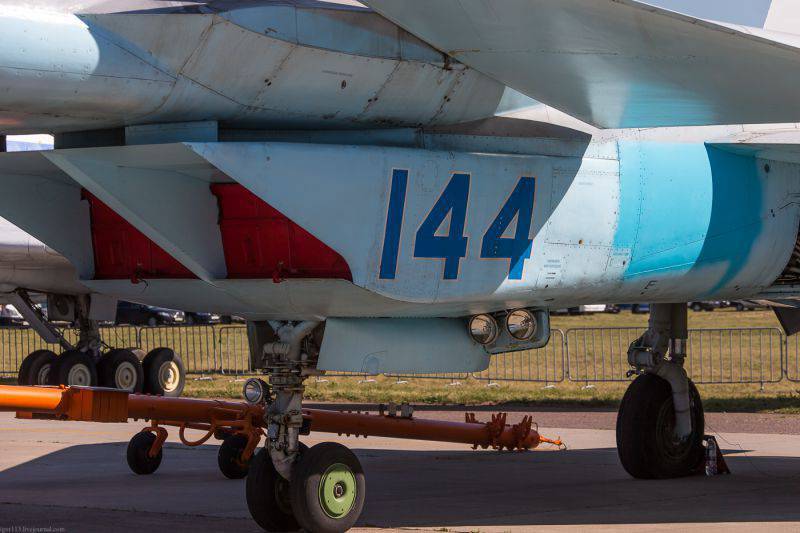
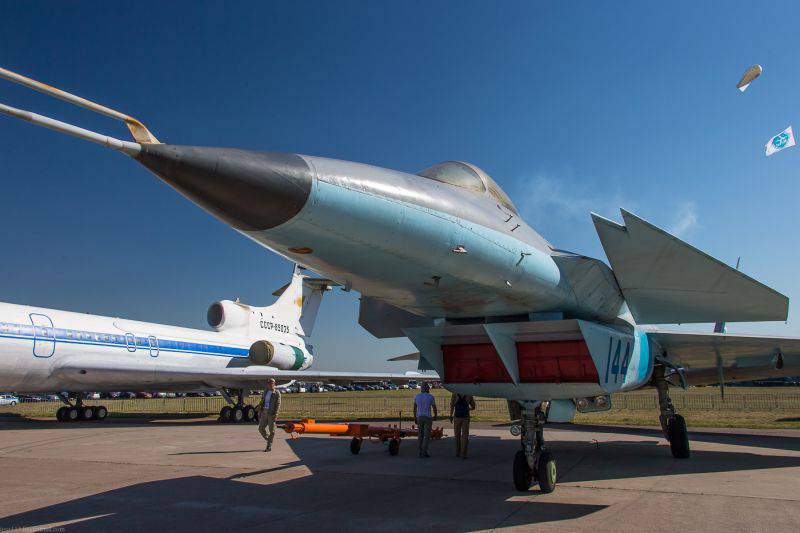
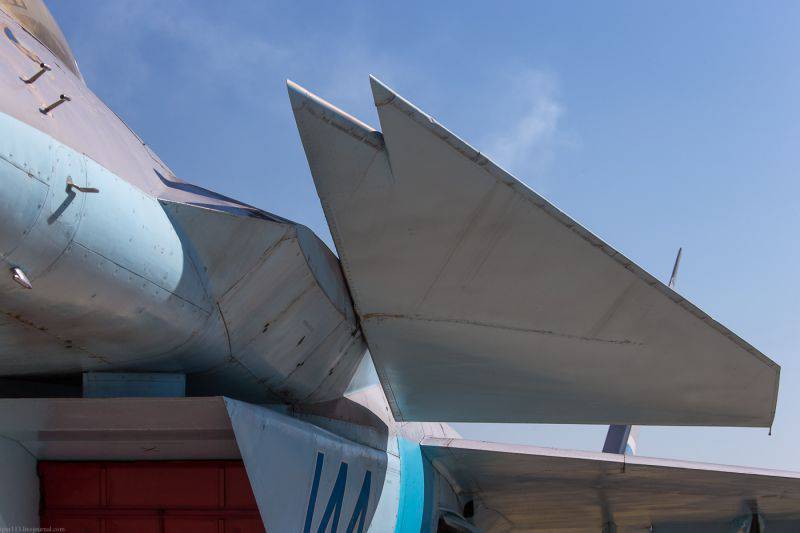
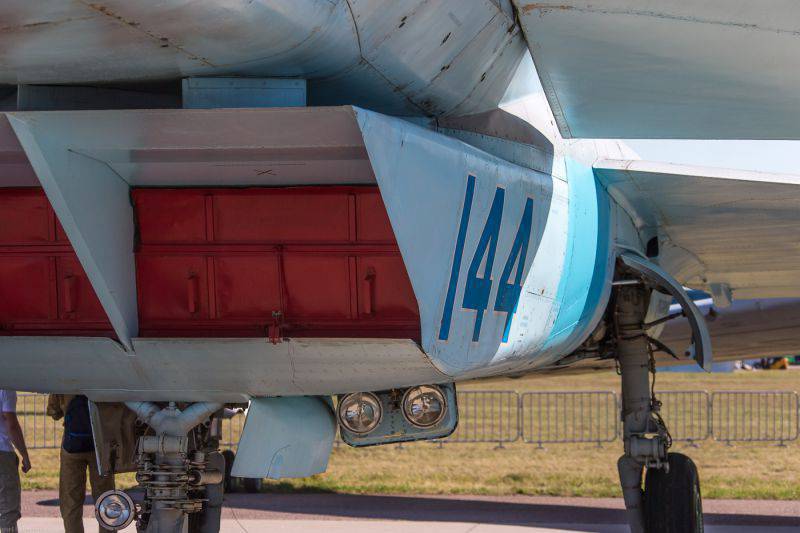
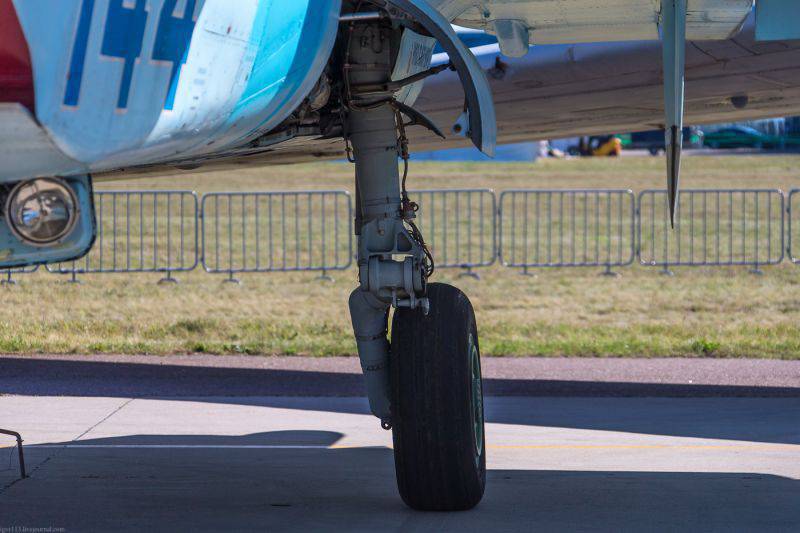
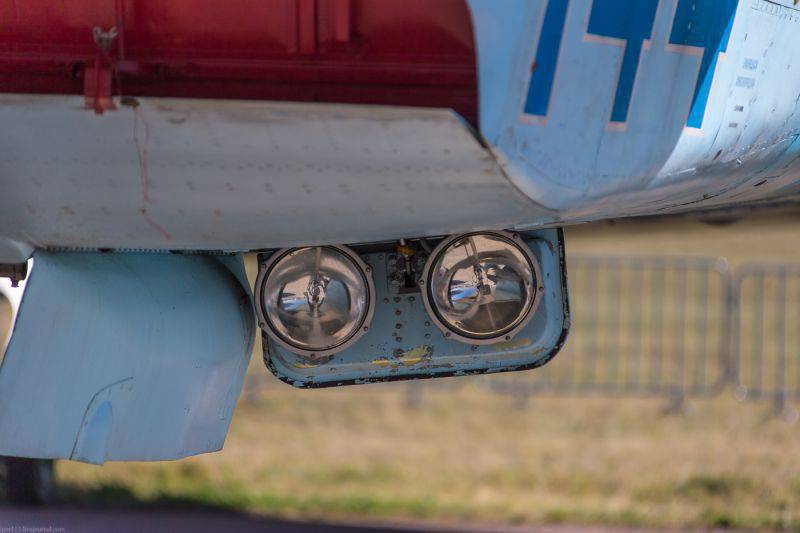
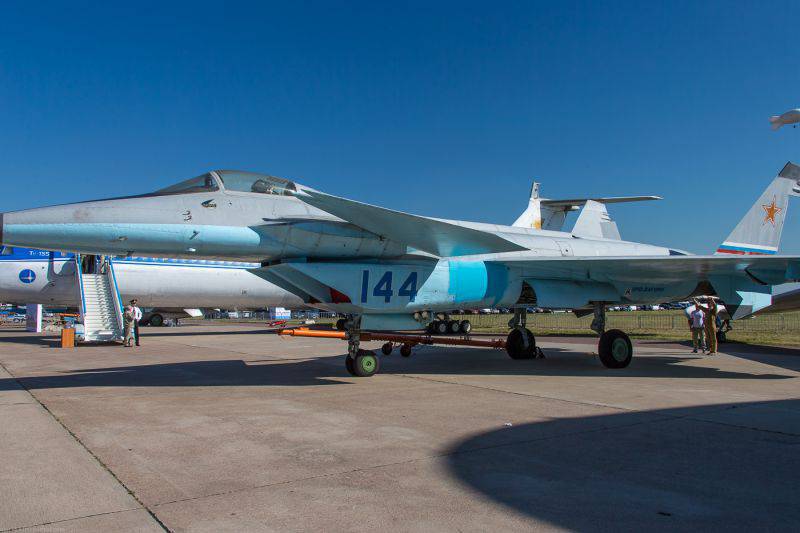
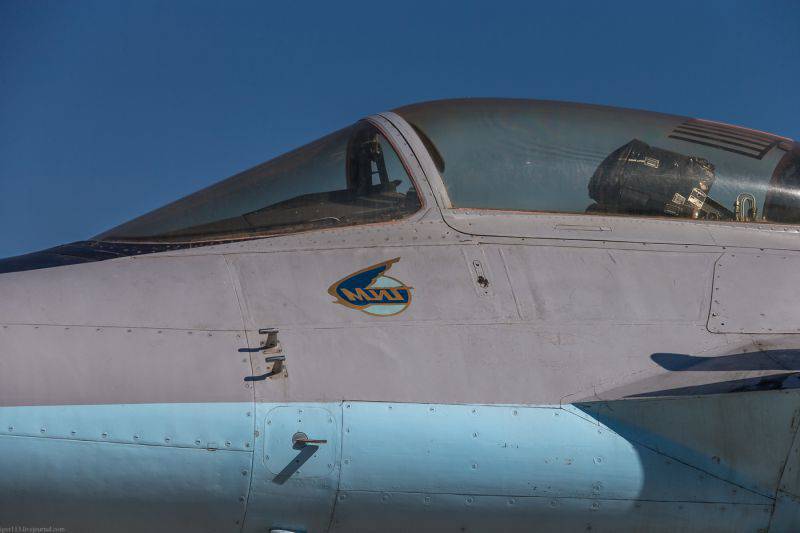
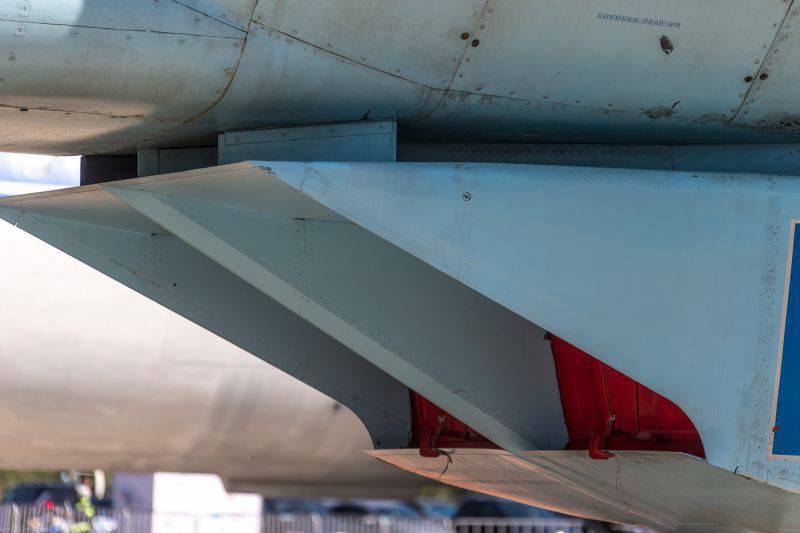
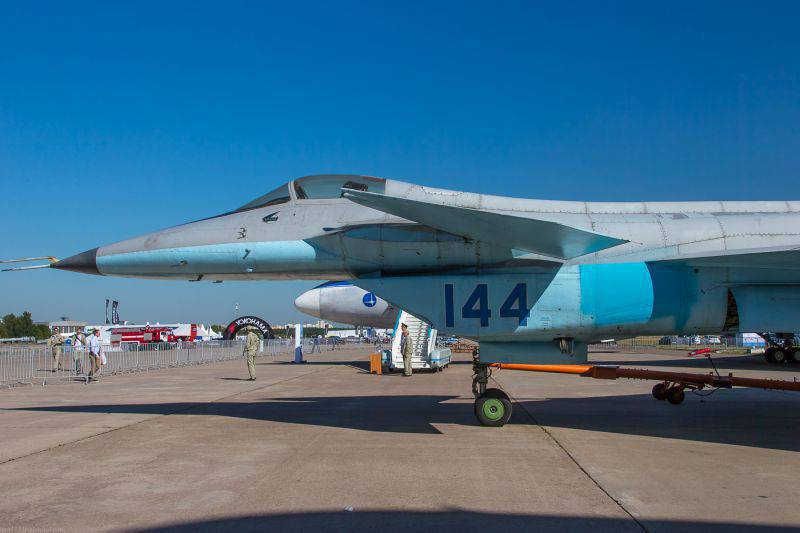
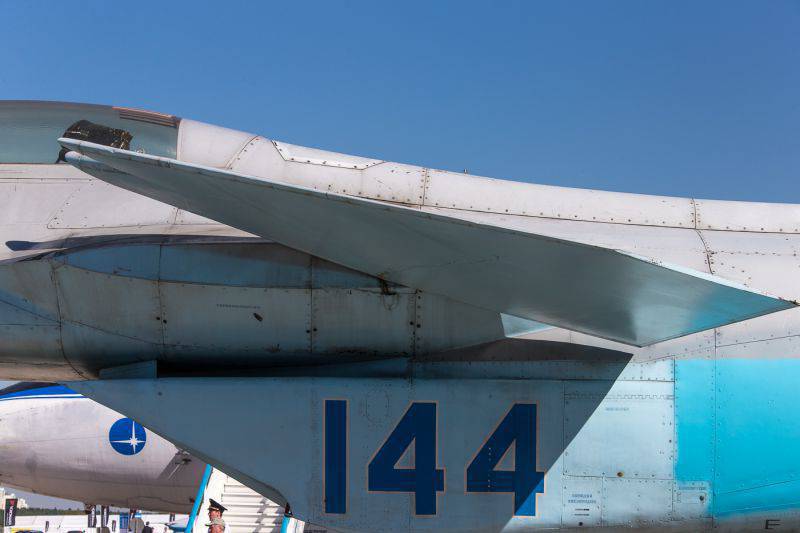


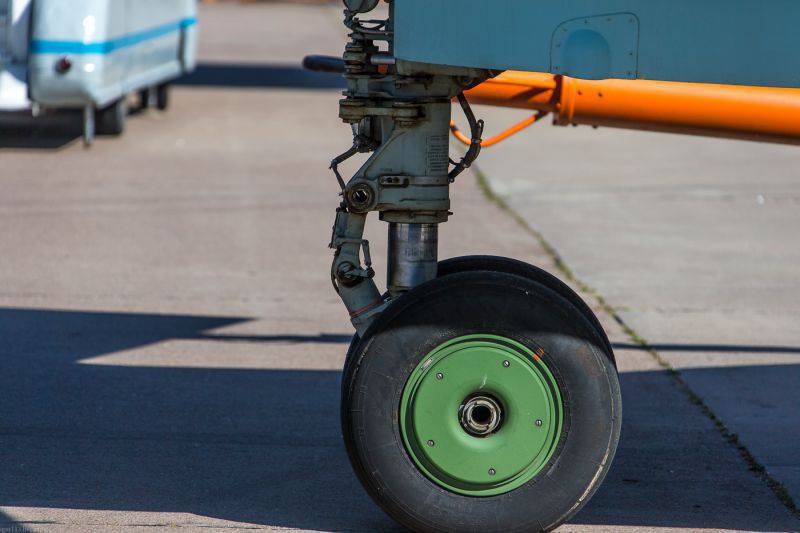
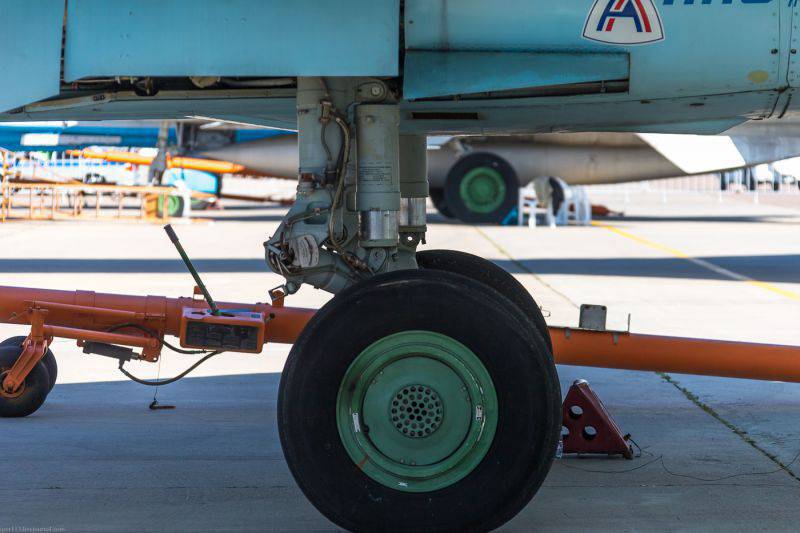
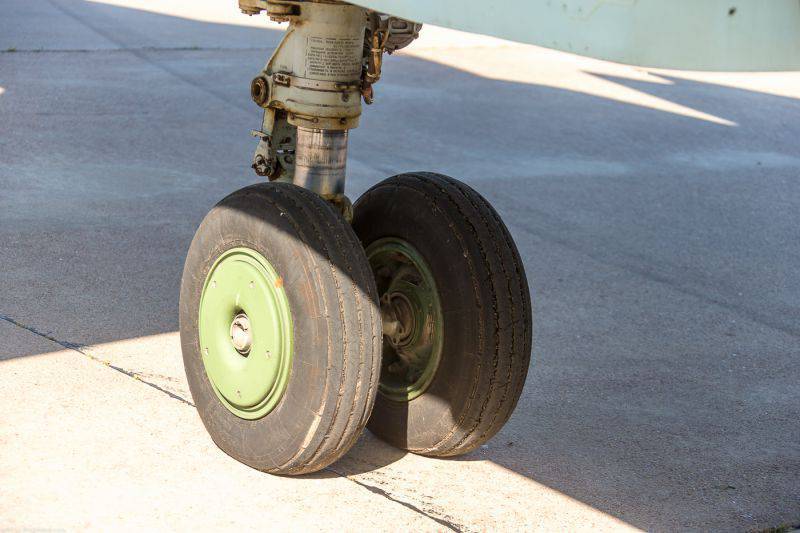
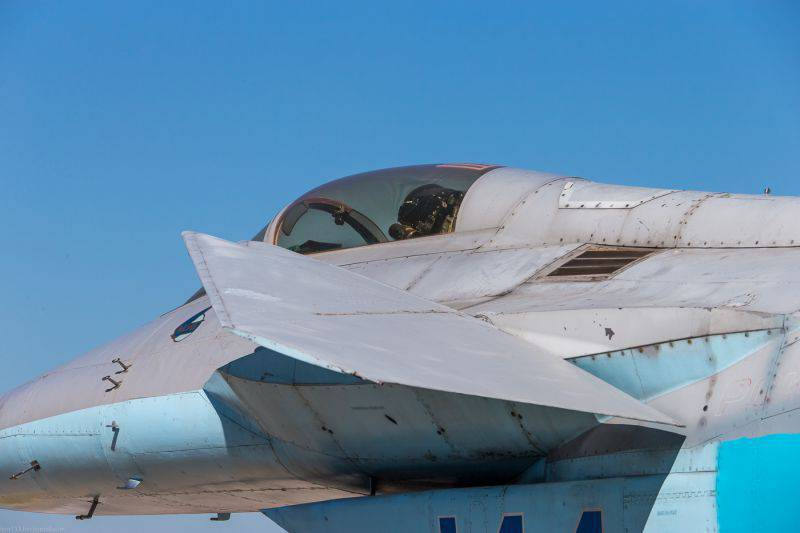
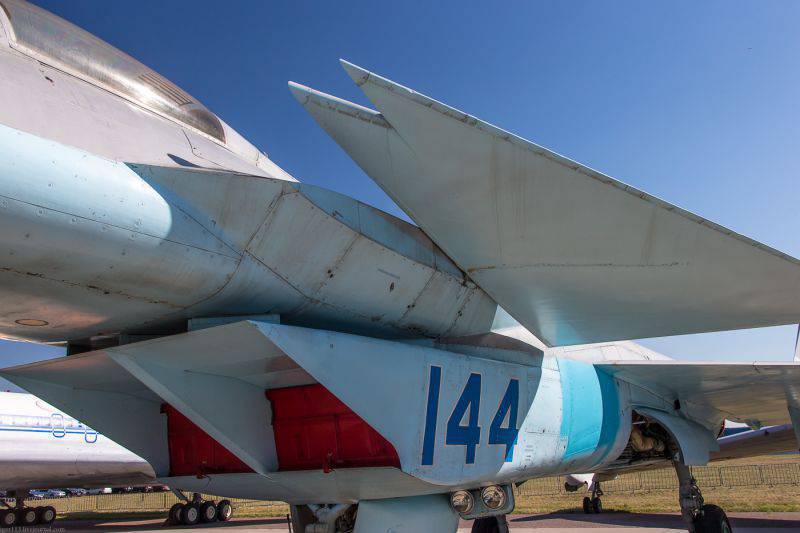
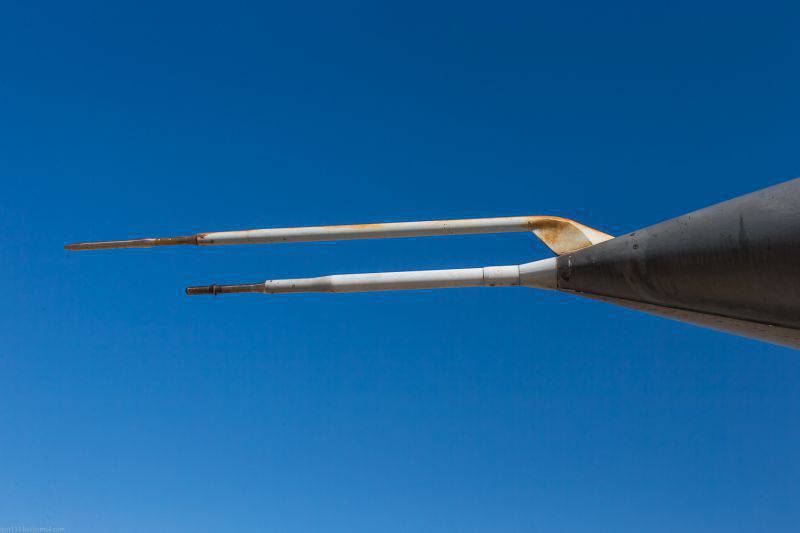
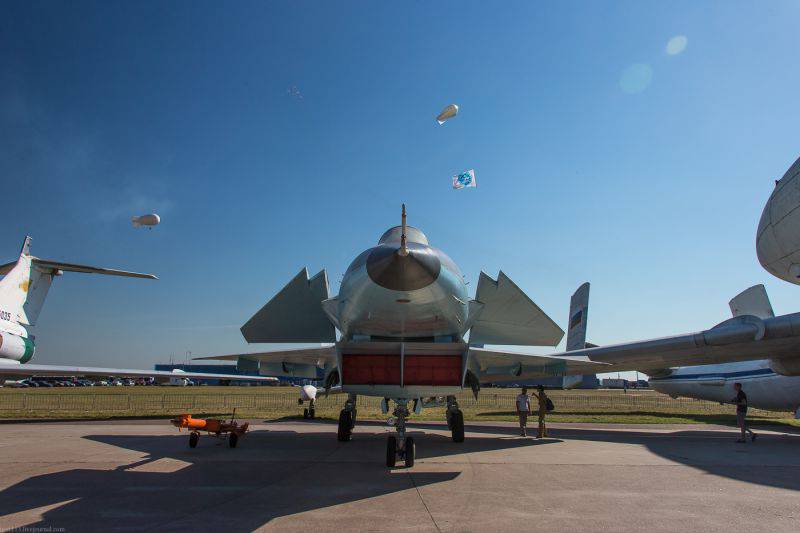
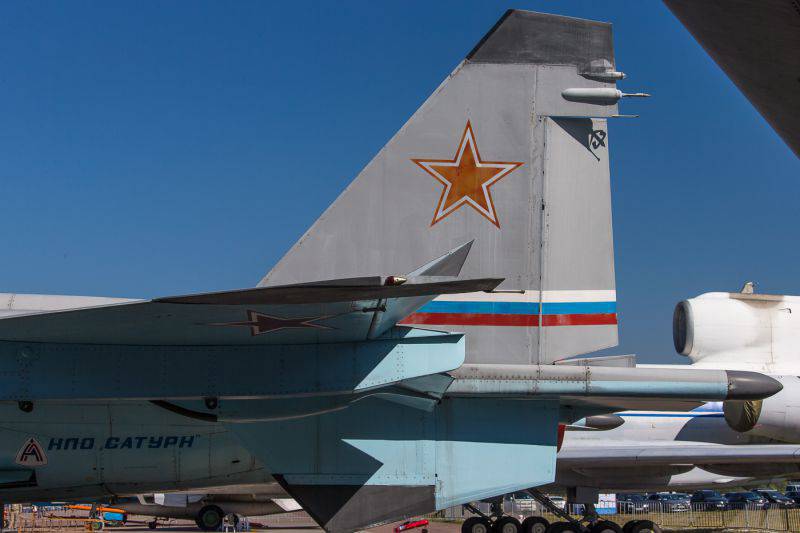
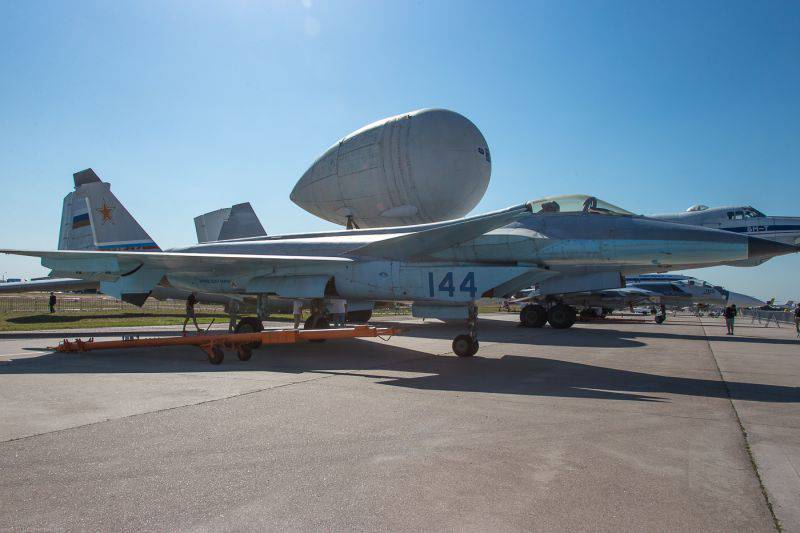
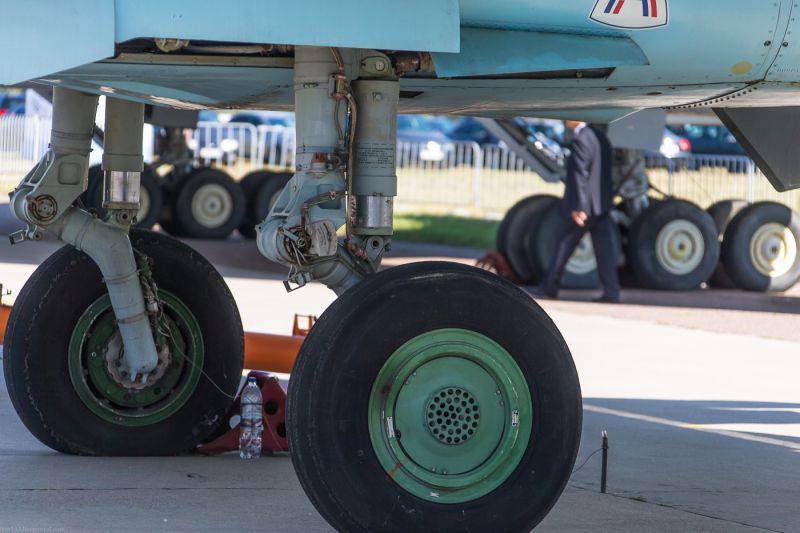
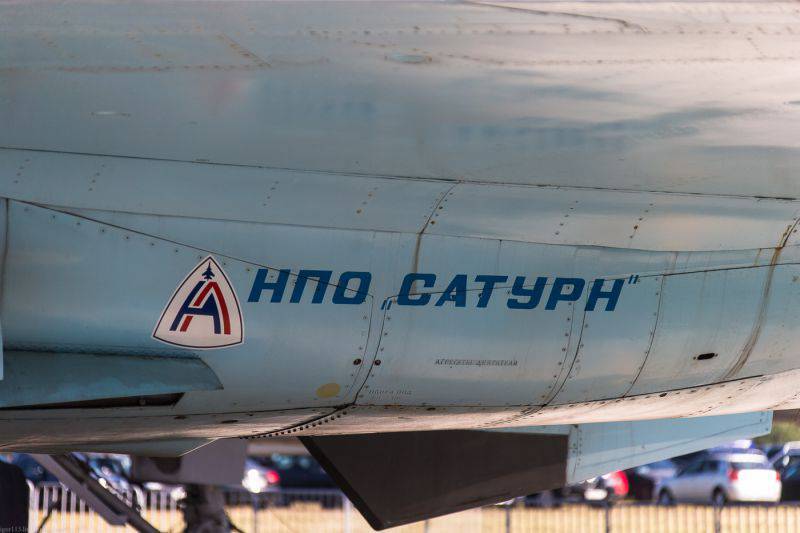
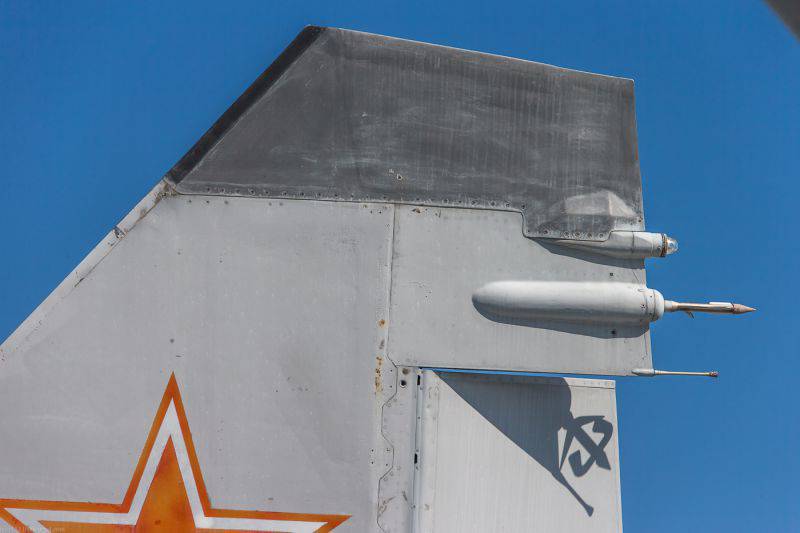
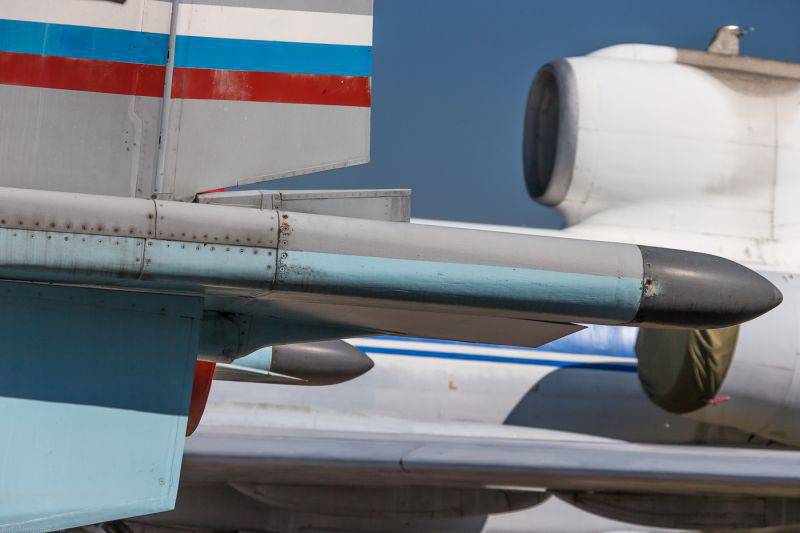
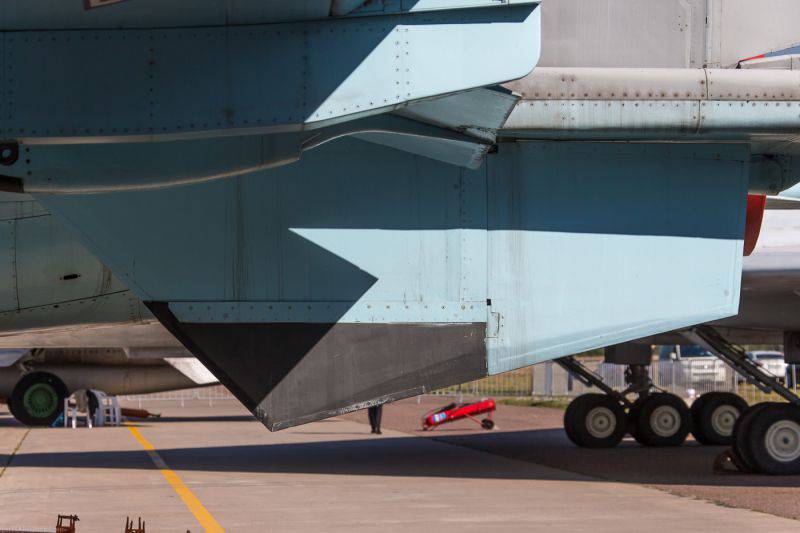
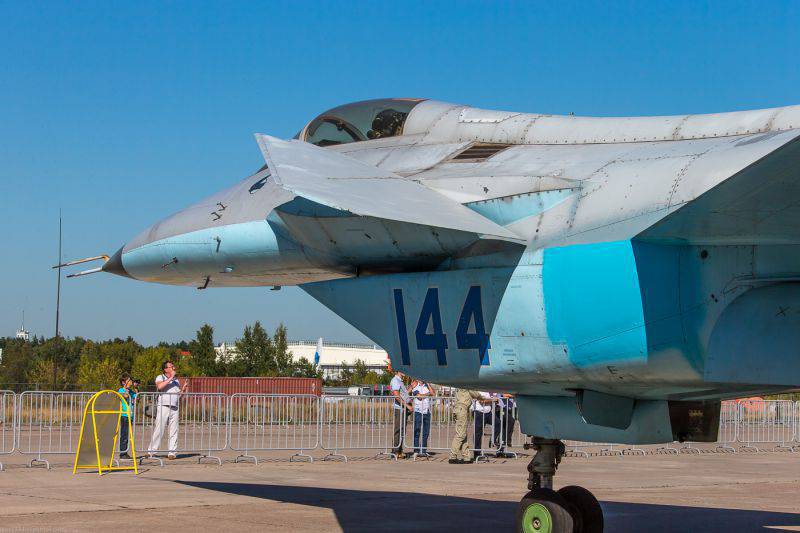
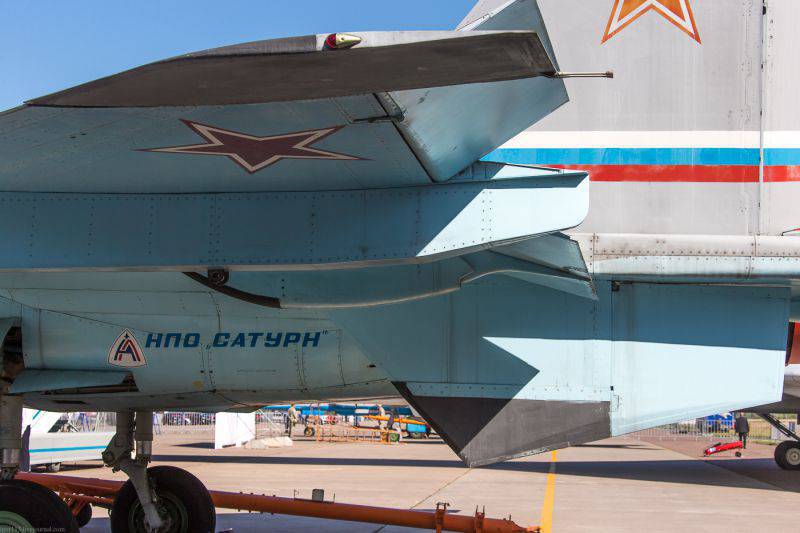
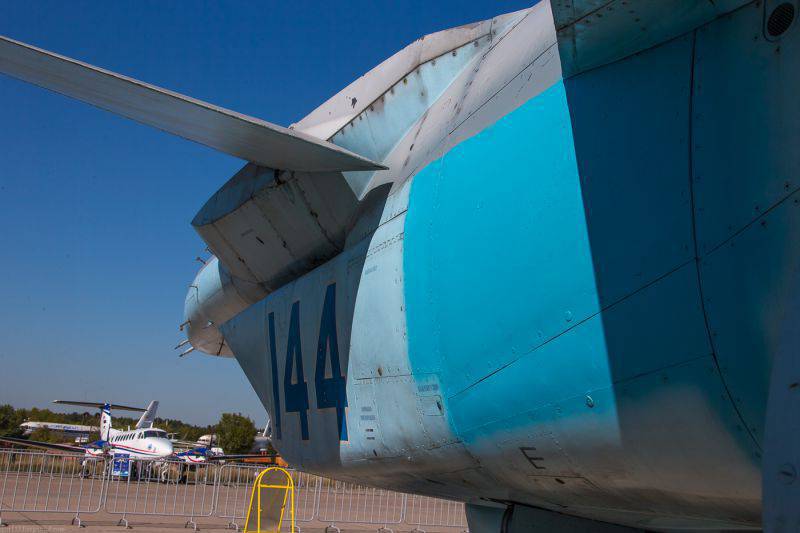
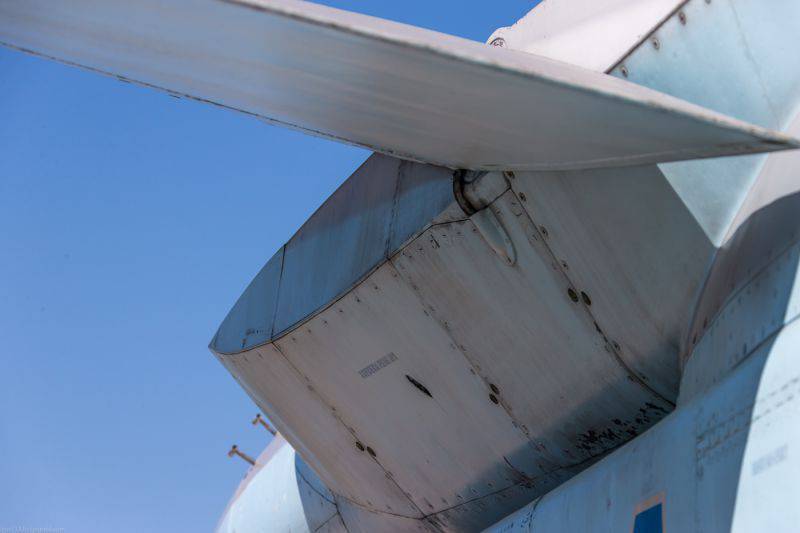
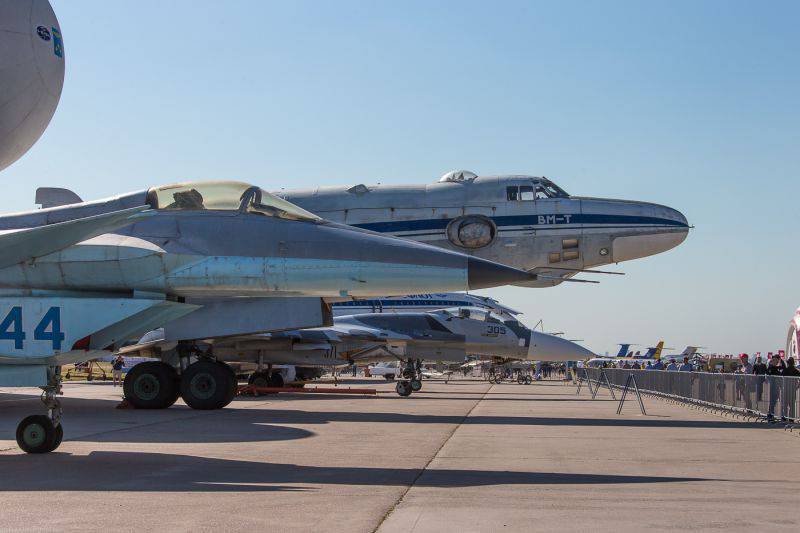
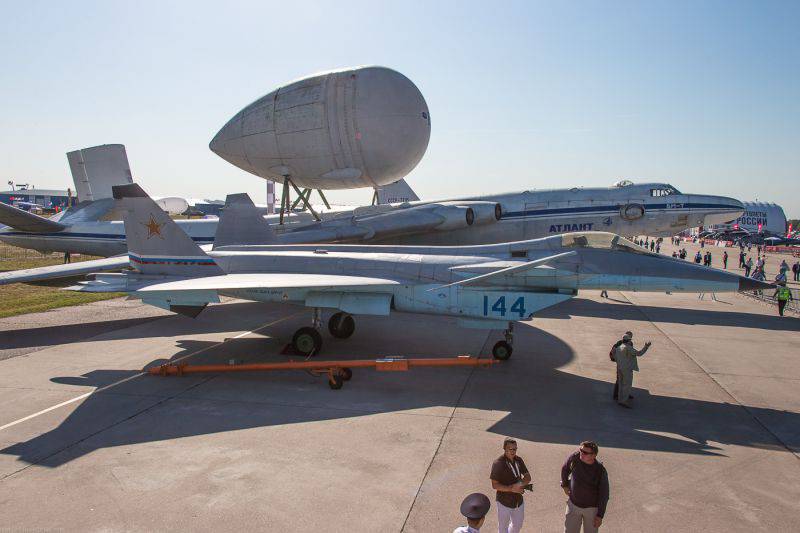
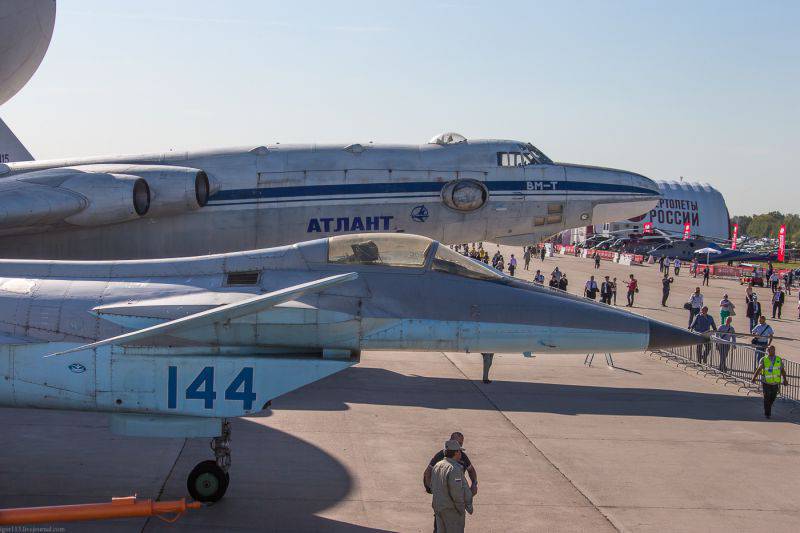
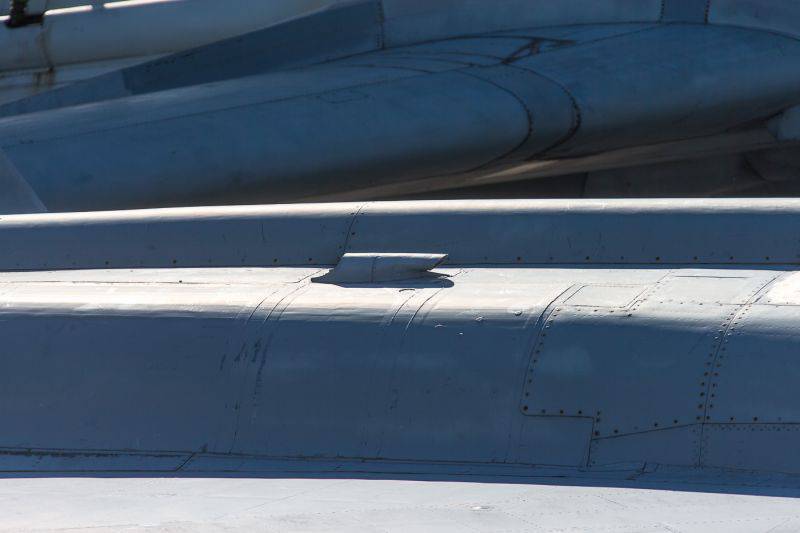
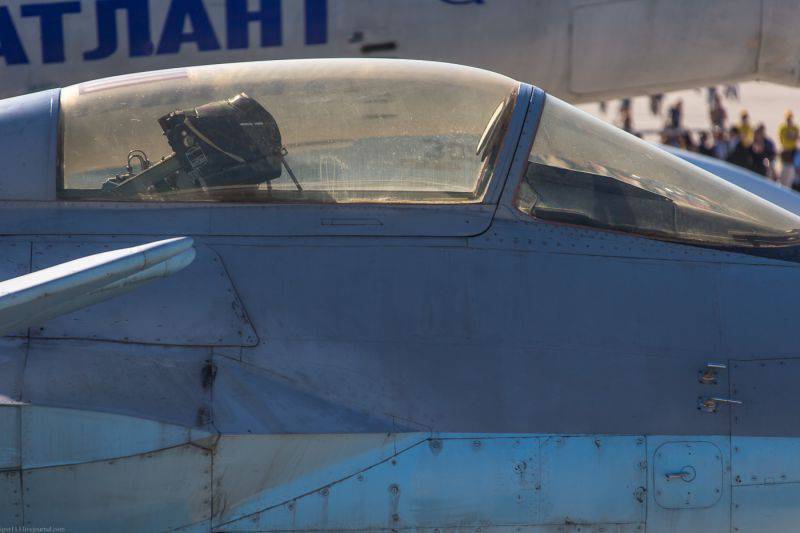
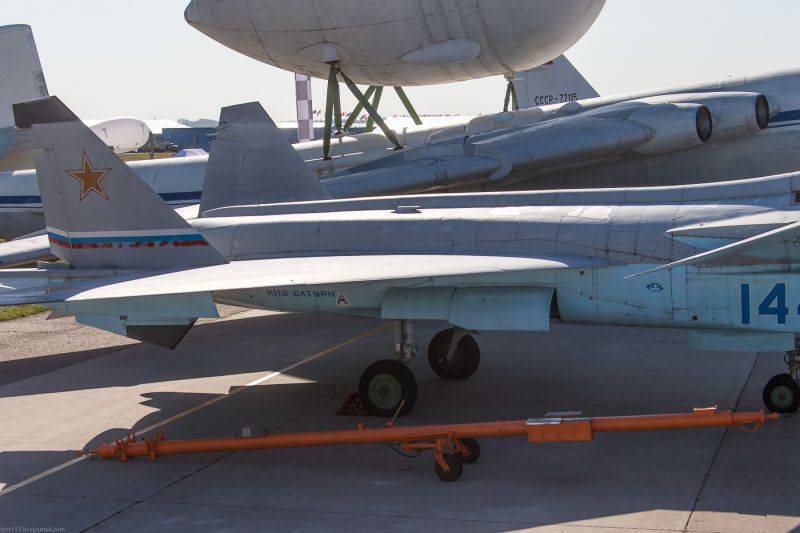
Information